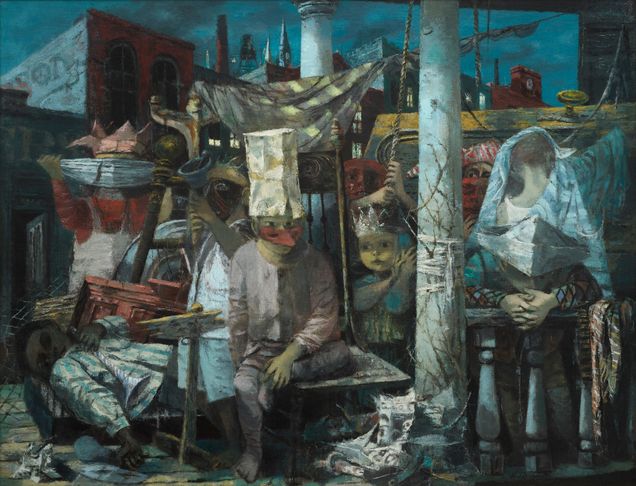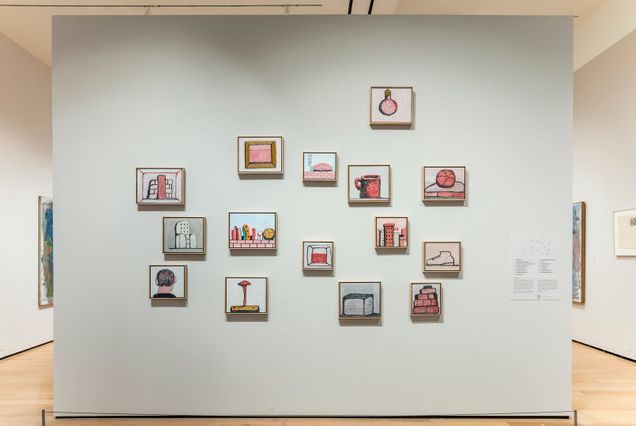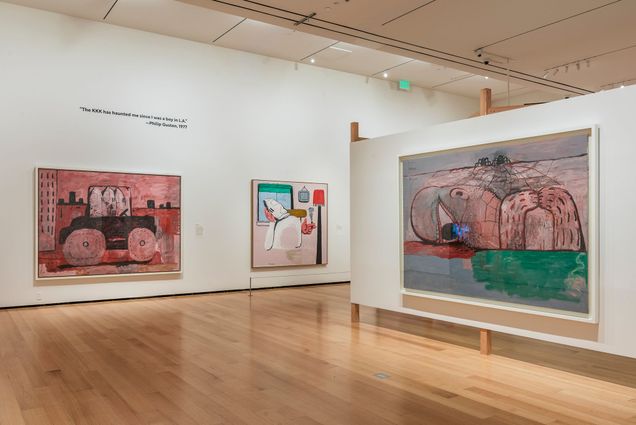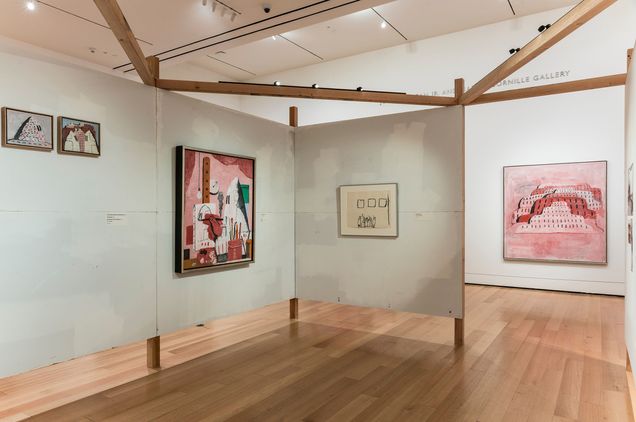“Philip Guston Now”
Museum of Fine Arts, Boston
May 1–September 11, 2022
by Ateret Sultan-Reisler

Philip Guston (1913–1980) responded to events witnessed in person and print through painting. Guston’s The Tormentors (1947–1948), an enigmatic rectangle of cadmium red and ink black overlaid with thin organic forms, requires further interpretation. The title hints at the artist’s explained reaction to seeing a Life Magazine article documenting the resurgence of Ku Klux Klan activity in 1946.1 Yet, this was not the first time Guston experienced the racist organization; a son of Jewish immigrants, the artist witnessed KKK marches growing up in Los Angeles. Curators and scholars generally analyze Guston’s oeuvre in the context of his personal anecdotes and broader art movements.2 However, his largest retrospective in two decades, MFA Boston’s Philip Guston Now grounds the artist’s personal experience and practice within a historical framework.3 Deciphering Guston’s reflections on harsh antisemitism and racism necessitates analysis of the chilling news reports he consumed. The retrospective tangibly brings a turbulent American political, racial, and militaristic climate to the fore: Philip Guston Now considers the artist’s work in dialogue with period news media and asks viewers to consider the artist’s work not only as personal meditation but as response to national and global oppression.
In a collapsed chronological order, the galleries show Guston’s early figuration, move to abstraction, and ultimate return to figuration. The first gallery spotlights Guston’s If this Be Not I, a demonstration of Guston’s earliest impulse to respond to worldwide issues. In the painting, masked and crowned children stage a performance on a street littered with newspaper and debris (fig. 1).4 The second gallery brings on the primarily sequential exhibition. In Guston’s early work, Madonna and Christ child embrace and nudes pose in celestial, Surrealist-inspired settings. The curators cite these paintings as aesthetically inspired by Max Ernst and Giorgio de Chirico.5 However, soon after, news of World War II brought forth issues demanding critical response. While teaching at Washington University, St. Louis in 1945, Guston first learned of the atrocities of World War II. Lest We Forget, a 1945 exhibition of Joseph Pulitzer Jr.’s photographs of liberated concentration camps, inspired Guston to depict the suffering he witnessed in a series of highly inscrutable paintings.6 Juxtaposing these works with visual testaments to the victims of Nazi violence urges viewers to consider how Guston’s work speaks to atrocities observed from afar.


Next, the exhibition features Guston’s brief period of abstraction followed by his racially charged work. Following Guston’s vivid action paintings conjuring the New York School, renderings of everyday domestic objects are scattered quirkily across a wall (fig. 2). However, Guston’s next body of work reacted to the unrest of the Civil Rights Era—a period in which Black activists brought racial oppression and white supremacy to the political forefront. Sparked by the tumult, Guston spoke to these issues through road-tripping, smoking, and bumbling Ku Klux Klan figures (fig. 3). Considering the sensitivity of this imagery, the more challenging paintings can be viewed in a semi-enclosed vestibule (fig. 4). Critiqued at the 1970 Marlborough Gallery show for their lack of skill, Guston’s efforts to address pervading white guilt and racial oppression were overlooked.7 At the MFA, klansmen painted in bright white and pink were paired with films of police violence against Vietnam War and Civil Rights activists.8 Framing his works with media footage encourages viewers to reflect and question the ways Guston’s works critically responded to racial and political turbulence of his era.

The final galleries frame Guston’s late paintings as responses to a buildup of memories and invite visitor response. Some of the gallery space is devoted to personal meditations in which Guston grappled with losing his wife, Musa. Another section features Guston’s work whilst a teacher at Boston University when protests for desegregation erupted on campus.9 The response station, a place for visitors to hang written responses on a wall with wooden pegs, underscores the heaviness of the content and urges visitors to forge meaningful connections between Guston’s work and period events. So easily could Guston have become numb to the constant ebb and flow of injustice in the news cycle. However, the exhibition’s grounding of shocking media pushes the argument that Guston fought against bigotry as a mundane feature of life. The exhibition urges viewers to reckon with how Guston’s method of bearing witness resonates with injustices broadcasted today.
____________________
Ateret Sultan-Reisler is the John Wilmerding Intern in American Art at National Gallery of Art, Washington D.C. She is working on a major retrospective of Elizabeth Catlett (2024–25). Ateret holds an MA in History of Art & Architecture from Boston University and a BA in Art History and Psychology from University of Maryland.
____________________
Footnotes
1. As a winner of the Carnegie Institute prize for painting, Guston was featured in the back of a 1946 Life Magazine issue. It is possible that The Tormentors (1947–1948) was in reaction to the article: “Ku Klux Klan Tries a Comeback,” Life, May 27, 1946.
2. For the preceding Guston retrospective consult Michael Auping and Ashton Dore, Philip Guston Retrospective (Fort Worth: Modern Art Museum of Fort Worth, 2003).
3. The MFA Boston curatorial team included Megan Bernard, Ethan W. Lasser, Kate Nesin, and Terence Washington.
4. In an earlier published version of this essay, the image The Porch (1945) was included instead of If This Be Not I (1945). It was amended for accuracy on May 14, 2023.
5. For further Guston scholarship, see the exhibition catalog, Harry Cooper, Mark Godfrey, Alison de Lima Greene, Kate Nesin, Philip Guston Now (Washington: National Gallery of Art, 2020).
6. The photographs were taken from Joseph Pulitzer Jr.’s “A Report to the American People,” St. Louis Post-Dispatch, 1945. These visual testaments of victims to Nazi-orchestrated concentration camps can be viewed in the exhibition by lifting a fabric case covering. Guston explained that viewing imagery of the unspeakable horrors of the Holocaust led him to create highly obscured paintings.
7. Guston’s Klansmen continue to cause controversy today. The multi-venue exhibition was originally slated to open in 2020, but was postponed due to the pandemic and a reckoning with racial violence in the U.S. The curators at MFA Boston; National Gallery of Art, Washington DC; MFA Houston; and Tate Modern, London took time to bolster their interpretation framework for challenging subject matter and reconsidered the installation design for the Klansmen pictures to enhance viewer sensitivity.
8. Media footage includes that from the Democratic National Convention, August 26–29, 1968; Vietnam War, footage from late 1960s–early 1970s; Kent State shooting, May 4, 1970; Richard Nixon, U.S. President, 1960–1974. This footage was captured or is owned by Onyx Media, Nexstar WGN, Chicago, ABC News, NBC News, Hearst Newsreel, Christopher Jensen, ITN, and Encyclopedia Britannica Films.
9. Museum of Fine Arts, Boston exhibition text.